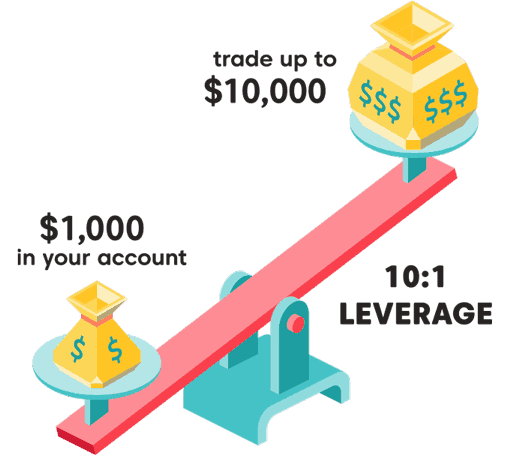Brokers With Low Leverage



Brokers with low leverage enable traders to manage risk when trading derivatives. Higher leverage means greater risk. This guide explains how trading with low leverage works and examines common leverage ratios and models. Read on for a list of the benefits and drawbacks of trading using lower leverage accounts. We have also ranked and compared the best companies and brokers with low leverage in 2025.
Brokers With Low Leverage
Here is a short summary of why we think each broker belongs in this top list:
- Interactive Brokers - Interactive Brokers (IBKR) is a premier brokerage, providing access to 150 markets in 33 countries, along with a suite of comprehensive investment services. With over 40 years of experience, this Nasdaq-listed firm adheres to stringent regulations by the SEC, FCA, CIRO, and SFC, amongst others, and is one of the most trusted brokers for trading around the globe.
- Gemini - Gemini is a cryptocurrency exchange set up in 2014 by the Winklevoss brothers, known for their early involvement in Facebook. The exchange is among the world’s 20 largest and most popular. Gemini clients can trade and stake 110+ cryptocurrencies, with derivatives trading available in some jurisdictions, an advanced proprietary platform and additional features including an NFT marketplace.
- Kraken - Kraken is a leading cryptocurrency exchange with a proprietary trading terminal and a list of 220+ tradeable crypto tokens. Up to 1:5 leverage is available with stable rollover fees on spot crypto trading and up to 1:50 on futures. The exchange also supports crypto staking and has an interactive NFT marketplace.
- Crypto.com - Crypto.com is one of the biggest names in cryptocurrency trading, developed with the aim to expedite the world's transition to DeFi technologies. The crypto exchange offers token lending, pre-paid cards, NFTs and more. The firm was established in Germany in 2016 and its quality is proven by its 150 million users.
- Coinbase - Launched in 2012 as a platform enabling users to buy and sell Bitcoin via bank transfers, Coinbase has emerged as a crypto behemoth, expanding its services to include 240+ crypto assets, developing sophisticated trading platforms for retail investors, listing on the US Nasdaq, and securing licenses with multiple regulators. In May 2025, Coinbase also became the first crypto company to join the S&P 500, a milestone that enhances its credibility.
- Exness - Established in 2008, Exness has maintained its position as a highly respected broker, standing out with its industry-leading range of 40+ account currencies, growing selection of CFD instruments, and intuitive web platform complete with useful extras like currency convertors and trading calculators.
Interactive Brokers
"Interactive Brokers is one of the best brokers for advanced day traders, providing powerful charting platforms, real-time data, and customizable layouts, notably through the new IBKR Desktop application. Its superb pricing and advanced order options also make it highly attractive for day traders, while its diverse range of equities is still among the best in the industry."
Christian Harris, Reviewer
Interactive Brokers Quick Facts
| Demo Account | Yes |
|---|---|
| Instruments | Stocks, Options, Futures, Forex, Funds, Bonds, ETFs, Mutual Funds, CFDs, Cryptocurrencies |
| Regulator | FCA, SEC, FINRA, CFTC, CBI, CIRO, SFC, MAS, MNB, FINMA, AFM |
| Platforms | Trader Workstation (TWS), IBKR Desktop, GlobalTrader, Mobile, Client Portal, AlgoTrader, OmniTrader, TradingView, eSignal, TradingCentral, ProRealTime, Quantower |
| Minimum Deposit | $0 |
| Minimum Trade | $100 |
| Leverage | 1:50 |
| Account Currencies | USD, EUR, GBP, CAD, AUD, INR, JPY, SEK, NOK, DKK, CHF, AED, HUF |
Pros
- Interactive Brokers has launched ForecastTrader, a unique, zero-commission product where users can trade yes/no Forecast Contracts on political, economic, and climate events, with fixed $1 payouts per contract, 24/6 market access, and 3.83% APY on held positions.
- IBKR continues to deliver unmatched access to global stocks with tens of thousands of equities available from 100+ market centres in 24 countries, most recently the Saudi Stock Exchange.
- With low commissions, tight spreads and a transparent fee structure, IBKR delivers a cost-effective environment for short-term traders.
Cons
- You can only have one active session per account, so you can’t have your desktop program and mobile app running simultaneously, making for a sometimes frustrating trading experience.
- TWS’s learning curve is steep, and beginners may find it challenging to navigate the platform and understand all the features. Plus500's web platform is much better suited to new traders.
- Support can be slow and frustrating based on tests, so you might find it challenging to reach customer service representatives promptly or encounter delays in resolving issues.
Gemini
"Gemini’s ActiveTrader platform and TradingView integration make it a good choice for serious crypto traders seeking a reliable charting environment, though we were disappointed by some unnecessary fees and previous security breaches."
Michael MacKenzie, Reviewer
Gemini Quick Facts
| Demo Account | No |
|---|---|
| Instruments | Cryptos |
| Regulator | NYDFS, MAS, FCA |
| Platforms | ActiveTrader, AlgoTrader, TradingView |
| Minimum Deposit | $0 |
| Minimum Trade | 0.00001 BTC |
| Account Currencies | USD, EUR, GBP, CAD, AUD, HKD, SGD |
Pros
- There is a decent range of educational guides and tutorials suitable for beginners
- The TradingView integration delivers top-quality tools, including backtesting and algo trading capabilities
- The exchange ensures high security standards with 2FA a requirement for all crypto investors
Cons
- There is no practice profile or demo account for prospective traders
- There are high fees for some funding methods including a 3.49% fee for card transactions
- Some larger coins by market cap are not available to buy through Gemini
Kraken
"Kraken will suit traders looking for a diverse list of cryptos including Bitcoin and a good security track record."
William Berg, Reviewer
Kraken Quick Facts
| Demo Account | Yes |
|---|---|
| Instruments | Cryptos |
| Regulator | FCA, FinCEN, FINTRAC, AUSTRAC, FSA |
| Platforms | AlgoTrader, Quantower |
| Minimum Deposit | $10 |
| Minimum Trade | Variable |
| Account Currencies | USD, EUR, GBP, CAD, AUD, JPY, CHF |
Pros
- 50x leverage on futures trading
- NFT marketplace and crypto staking available
- Low minimum deposit of $10
Cons
- Does not accept fiat deposits
- Slow verification process on Pro account
- Low leverage on spot trading
Crypto.com
"Crypto.com is a snug fit for aspiring crypto traders who want to buy, sell and trade over 400 digital tokens. The interest paid on idle funds and intuitive staking opportunities also provide passive investing opportunities."
Christian Harris, Reviewer
Crypto.com Quick Facts
| Demo Account | No |
|---|---|
| Instruments | Crypto, Stocks, ETFs |
| Regulator | SEC, FCA, MAS, AMF, CySEC, CBI, ASIC, FINTRAC, CIMA, VARA, OAM, HCMC, CFTC, OSC, KoFIU |
| Platforms | Own |
| Minimum Deposit | $0 |
| Minimum Trade | $1 |
| Account Currencies | USD, EUR, GBP, CAD, AUD, NZD, ZAR, TRY, SEK, NOK, DKK, CHF, HKD, PLN, CZK, AED, SAR, HUF, BRL, KES |
Pros
- The Crypto.com Exchange platform offers sophisticated bots, including Dollar Cost Averaging (DCA), Time-Weighted Average Price (TWAP), and Grid Trading bots. These tools allow traders to automate strategies, including leveraged perpetual trades, minimizing manual effort and slippage.
- The platform supports unified portfolio tracking across cryptocurrencies, stocks, ETFs, and more recently prediction markets, all within a single interface, simplifying asset management for multi-asset traders and providing consolidated insights.
- Crypto.com has expanded beyond crypto in some regions, offering over 5000 stocks and ETFs for traders looking to build diverse portfolios and opportunities in different sectors.
Cons
- The app's high bid-ask spreads on many coins can be costly for traders placing market orders. Wide spreads mean the price you pay when buying is noticeably higher than the price you receive when selling, cutting into profits, especially on lower-volume trades.
- Customer support primarily relies on chatbots and email, with limited reliable phone support from our testing. This can lead to delays in resolving urgent issues, such as account access or transaction problems, which can be frustrating for crypto day traders who need quick assistance.
- Withdrawal fees apply to crypto transfers and fiat withdrawals, and these can be significant for active traders making smaller transfers. The minimum withdrawal limits are also relatively high, which restricts flexibility for managing smaller portfolios or quick liquidity needs.
Coinbase
"Coinbase is ideal for beginners looking for an intuitive platform to buy and sell a wide variety of cryptocurrencies, with robust security and regulatory compliance. However, its fees are higher compared to competitors in our tests, and it’s not as tailored for short-term traders."
Christian Harris, Reviewer
Coinbase Quick Facts
| Demo Account | No |
|---|---|
| Instruments | Crypto |
| Regulator | FinCEN, FCA, CBoI, MAS, OAM, DNB, BdE |
| Platforms | Coinbase, Advanced Trade, Wallet, NFT, TradingView |
| Minimum Deposit | $0 |
| Minimum Trade | $2 |
| Account Currencies | USD, EUR |
Pros
- As a Nasdaq-listed company, Coinbase follows strict financial regulations, with licensing across the US, UK, and Europe. Security includes FDIC insurance for USD balances (up to $250,000) and two-factor authentication (2FA).
- Coinbase supports 240+ cryptocurrencies, including Bitcoin (BTC), Ethereum (ETH), Solana (SOL), and more recently listed altcoins like $Trump, giving early access to emerging tokens.
- Coinbase Advanced bolstered its leveraged trading offering with a suite of new futures products in 2025, including Ripple (XRP), Natural Gas (NGS), and Cardano (ADA), providing accessible ways to trade, hedge, or diversify.
Cons
- Frustrating customer support during testing, with most help options hidden behind login, making it tough for locked-out users or non-account holders to get assistance.
- There are woeful research tools; Advanced Trade has TradingView charts but lacks features like news feeds, economic calendars, and AI market insights.
- High crypto fees based on tests, especially compared to competitors like Kraken and BitMEX, and notably on the standard dealing platform.
Exness
"After slashing its spreads, improving its execution speeds and support trading on over 100 currency pairs with more than 40 account currencies to choose from, Exness is a fantastic option for active forex traders looking to minimize trading costs."
Christian Harris, Reviewer
Exness Quick Facts
| Demo Account | Yes |
|---|---|
| Instruments | CFDs on Forex, Stocks, Indices, Commodities, Crypto |
| Regulator | FCA, FSCA, CMA, FSA, CBCS, BVIFSC, FSC, JSC |
| Platforms | Exness Trade App, Exness Terminal, MT4, MT5, TradingCentral |
| Minimum Deposit | Varies based on the payment system |
| Minimum Trade | 0.01 Lots |
| Leverage | 1:Unlimited |
| Account Currencies | USD, EUR, GBP, CAD, AUD, NZD, INR, JPY, ZAR, MYR, IDR, CHF, HKD, SGD, AED, SAR, HUF, BRL, NGN, THB, VND, UAH, KWD, QAR, KRW, MXN, KES, CNY |
Pros
- Improved execution speeds, now averaging under 25ms, offer optimal conditions for short-term traders.
- Excellent range of account types for all experience levels, including Cent, Pro plus the introduction of Raw Spread, ideal for day traders.
- Fast and dependable 24/7 multilingual customer support via telephone, email and live chat based on hands-on tests.
Cons
- MetaTrader 4 and 5 are supported, but TradingView and cTrader still aren’t despite rising demand from active traders and integration at alternatives like Pepperstone.
- Apart from a mediocre blog, educational resources are woeful, especially compared to category leaders like IG which provide a more complete trading journey for newer traders.
- Exness has expanded its range of CFDs and added a copy trading feature, but there are still no real assets such as ETFs, cryptocurrencies or bonds
How Does Leverage Work?
In basic terms, leverage trading works in a similar way to borrowing. Your broker lends you money to open larger position sizes, and in turn, you can make a greater profit.
Leverage is often shown as a ratio which represents the balance of the loan capital (from the broker) to the value of the full equity (the amount the trader invests).
For example, a broker offering 1:5 leverage means for every $10 invested, you can borrow up to $50. This gives traders the chance to multiply the results of a trade.
Importantly however, trading on leverage can magnify losses. So in highly volatile markets, such as cryptos, you can use lower leverage to protect yourself from losing money quickly. This is also why brokers with low leverage are popular with traders starting out.
Examples
Let’s say a trader starts with a $100 deposit, and their broker offers a 1:10 leveraged ratio on commodities. This means that they can trade in positions up to ten times the value of their available balance, so a maximum of $1000.
They invest $1000 in crude oil and the value of crude oil rises by 10%, so the trader earns $100 in profit ($1000 * 1.1 = $1100). However, if they had purchased $100 worth of crude oil without leverage on the same trade, their profit would be $10 ($100 * 1.1 = $110).

Alternatively, say a trader has a $100 deposit and their broker offers higher leverage at 1:100. They invest $10,000 ($1000 * 100) in Apple stocks but the value of the stock plummets by 10% so the trader loses $1000 ($10,000 * 0.9 = $9,000), 10 times their initial deposit.
So, while leveraged trades can magnify your profits, brokers with low leverage can help avoid larger losses.
Note, the examples above do not take into account any fees you may have to pay to trade on margin.
What Is Considered Low Leverage?
Generally, low leverage is considered to be below 1:30. However, leverage can vary depending on the markets you’re investing in.
The most trusted brokers that offer lower leverage are regulated by the FCA (UK), ASIC (Australia) and CySEC (Europe). These financial watchdogs typically limit leverage rates based on the market in question. Common leverage ratios include:
- 1:30 – Major forex pairs, for example, EUR/USD and GBP/USD
- 1:20 – Gold, minor forex pairs, major stock market indices, for example, NYSE and FTSE 100
- 1:10 – Commodities and minor indices, for example, energies like oil
- 1:5 – Stocks and shares, for example, Amazon, Microsoft, and Tesla
- 1:2 – Cryptocurrency assets, for example, Bitcoin, Ethereum and Litecoin
Pros Of Brokers With Low Leverage
- Gains With Reduced Risk – Using smaller leverage can benefit traders by slightly increasing their position size, and thus increasing their potential profits. With low leverage, the risk is minimized but bigger profits are still achievable.
- Lower Charges – Because leverage means that you borrow money, the broker can charge you fees for holding positions overnight or completing transactions. However, the cost structure with lower leverage means that you borrow less, and therefore you pay less in fees.
- Fewer Losses – As leverage boosts capital, it will also magnify any gains and losses. Choosing a broker with a lower rate of leverage will help to mitigate your losses, as you are exposed to less risk overall.
- Beginner-Friendly – Using brokers with low leverage is a more risk-conscious strategy, which makes it ideal for beginners who are still becoming familiar with a given market.
Cons Of Brokers With Low Leverage
- Limited Profits – When using a broker with lower leverage, your profit potential is limited by the rate of leverage they offer. There is no opportunity to make higher-risk trades that offer potentially larger returns.
- Restricts Your Portfolio – Signing up to a broker with low leverage means you may have fewer opportunities to diversify your portfolio. A trader using high leverage is more likely to have the capital to invest in multiple assets like REITs, CFDs, bonds, or cryptos.
How To Choose Brokers With Low Leverage
The key factors to consider when selecting a trading account with lower leverage include:
- Fees – Research the broker’s overall fee structure. Look for leverage transaction costs and any fees charged for keeping positions overnight.
- Available Assets – Ensure that your desired asset is available, whether that’s forex, equities, commodities or cryptocurrencies.
- Minimum Leverage – Check the level of minimum leverage offered on your chosen asset. Alternatively, we have compiled a list of the top brokers with low leverage.
- Negative Balance Protection – This is a useful feature offered by most regulated brokers. It protects your account from going negative even if the markets change rapidly. This is especially beneficial for new traders.
- Demo Account – Demo accounts enable you to practice trading with low leverage, and to establish if you are happy with the trading software offered by the brokerage. Free practice accounts are often the sign of a trusted broker.
- Supported Countries – Ensure that you’re allowed to use the broker in question. Whether you’re from the US, Canada or elsewhere, different brokers will only accept traders from certain jurisdictions.
Final Word On Brokers With Low Leverage
Brokers with low leverage offer clients the opportunity to benefit from trading on margin without the risks that higher leverage can bring.
It’s important to remember, however, that any form of leveraged trading can result in unpredictable losses. Beginners should open demo accounts to practise trading on margin, and ensure that they select the most trusted broker to protect their capital.
Nevertheless, low leverage is ideal for cautious investors looking to steadily build profits. See our list of the best brokers with low leverage trading to get started.
FAQs
Is Low Leverage Better For Beginners?
Whether you’re trading crypto, forex, stocks or bonds, for beginners a lower leverage ratio is good. This helps to reduce losses, which are more expected with newcomers who may make mistakes. Fortunately, most EU, UK and Australian-regulated trading brokers cap leverage for retail traders to 1:30.
Who Are The Top Regulated Brokers With Low Leverage?
Many of the best brokers offer low leverage options, and choosing a platform will depend on your individual needs. Some of the top low leveraged trading firms include XM, AvaTrade, eToro, Pepperstone and IG.
What Does Low Leverage Vs Low Margin Mean?
Leverage and margin both involve borrowing funds to trade. A leveraged position means a trader has taken on debt, while the margin is the actual money/ratio i.e loan taken to invest in financial markets. Both terms are often used interchangeably.
What Countries Allow Low Leveraged Trading?
Leveraged trading is regulated and legal in numerous countries across the globe. For example:
- US – National Futures Association (NFA)
- Australia – Australian Securities and Investments Commission (ASIC)
- UK and Europe – Financial Conduct Authority (FCA), the European Securities and Markets Authority (ESMA), Cyprus Securities & Exchange Commission (CySEC)
- Singapore – Monetary Authority of Singapore (MAS)
Note, in 2021 India banned the retail trading of many leveraged products.





